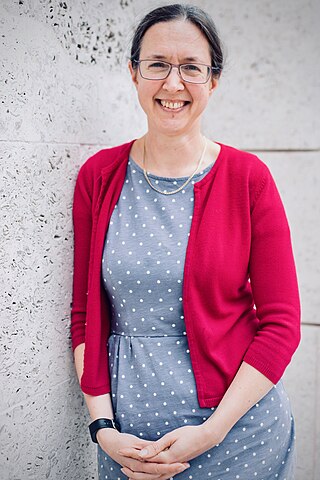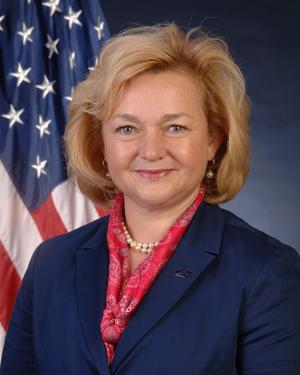
A microscope is a laboratory instrument used to examine objects that are too small to be seen by the naked eye. Microscopy is the science of investigating small objects and structures using a microscope. Microscopic means being invisible to the eye unless aided by a microscope.

John David Barrow was an English cosmologist, theoretical physicist, and mathematician. He served as Gresham Professor of Geometry at Gresham College from 2008 to 2011. Barrow was also a writer of popular science and an amateur playwright.
Calvin Forrest Quate was one of the inventors of the atomic force microscope. He was a professor emeritus of Applied Physics and Electrical Engineering at Stanford University.

The Department of Materials at the University of Oxford, England was founded in the 1950s as the Department of Metallurgy, by William Hume-Rothery, who was a reader in Oxford's Department of Inorganic Chemistry. It is part of the university's Mathematical, Physical and Life Sciences Division

George David William Smith FRS, FIMMM, FInstP, FRSC, CEng is a materials scientist with special interest in the study of the microstructure, composition and properties of engineering materials at the atomic level. He invented, together with Alfred Cerezo and Terry Godfrey, the Atom-Probe Tomograph in 1988.

A scanning acoustic microscope (SAM) is a device which uses focused sound to investigate, measure, or image an object. It is commonly used in failure analysis and non-destructive evaluation. It also has applications in biological and medical research. The semiconductor industry has found the SAM useful in detecting voids, cracks, and delaminations within microelectronic packages.

Nanometrology is a subfield of metrology, concerned with the science of measurement at the nanoscale level. Nanometrology has a crucial role in order to produce nanomaterials and devices with a high degree of accuracy and reliability in nanomanufacturing.
The following outline is provided as an overview of and topical guide to nanotechnology:

Nestor J. Zaluzec is an American scientist and inventor who works at Argonne National Laboratory. He invented and patented the Scanning Confocal Electron Microscope. and the π Steradian Transmission X-ray Detector for Electron-Optical Beam Lines and Microscopes.

Sir Colin John Humphreys, is a British physicist and Christian apologist. He is the Professor of Materials Science at Queen Mary University of London.
Andrew James Fisher is Professor of Physics in the Department of Physics and Astronomy at University College London. His team is part of the Condensed Matter and Materials Physics group, and based in the London Centre for Nanotechnology.
David Bernard Williams was the dean of the College of Engineering at the Ohio State University from 2011-2021. He was previously the fifth president of the University of Alabama in Huntsville in Huntsville, Alabama from March 2007 until April 2011, and Vice Provost for Research and Harold Chambers Senior Professor of Materials Science and Engineering at Lehigh University in Bethlehem, Pennsylvania.
Vlatko Vedral is a Serbian-born physicist and Professor in the Department of Physics at the University of Oxford and a Fellow of Wolfson College, Oxford. Until the summer of 2022 he also held a joint appointment at the Centre for Quantum Technologies (CQT) at the National University of Singapore. He is known for his research on the theory of quantum entanglement and quantum information theory. He has published numerous research papers, which are regularly cited, in quantum mechanics and quantum information, and was awarded the Royal Society Wolfson Research Merit Award in 2007. He has held a lectureship and readership at Imperial College, a professorship at Leeds and visiting professorships in Vienna, Singapore (NUS) and at the Perimeter Institute for Theoretical Physics in Canada. He is the author of several books, including Decoding Reality.

Roman Grigorievich Maev , is a Canadian professor of physics at the University of Windsor, distinguished university professor, the Foreign Member of the Russian Academy of Sciences (RAS) (2019), full professor in physics (2005), Dr. Sc. (2002), Ph. D. (1973). Dr. Maev is the founding director of the Institute for Diagnostic Imaging Research at the University of Windsor.

Rachel Angharad Oliver is a Professor of Materials Science at the University of Cambridge and a fellow of Robinson College, Cambridge. She works on characterisation techniques for gallium nitride materials for dark-emitting diodes and laser diodes.
Sandra J. Rosenthal is the Jack and Pamela Egan Professor of Chemistry, professor of physics and astronomy, pharmacology, chemical and biomolecular engineering, and materials science at Vanderbilt University. She is a joint faculty member at Oak Ridge National Laboratory in the Materials Science and Technology Division and the director of the Vanderbilt Institute of Nanoscale Science and Engineering.

Sonia Antoranz Contera is a Spanish physicist. She serves as Professor of Biological Physics at the University of Oxford, a senior fellow at the Oxford Martin School, and a senior research fellow at Green Templeton College.

Angela Renee Hight Walker is an American physicist. She is a project leader in the nanoscale spectroscopy group at the National Institute of Standards and Technology. Hight Walker's research includes advancing optical spectroscopic techniques and specifically their applicability to characterize quantum nanomaterials.
Peter David Nellist, is a British physicist and materials scientist, currently a professor in the Department of Materials at the University of Oxford. He is noted for pioneering new techniques in high-resolution electron microscopy.
Andrei Nikolaevich Khlobystov is a Russian-British scientist who is the Professor of Nanomaterials at the University of Nottingham. He serves as Director for Research for the School of Chemistry in the Faculty of Science and has received several awards during his career, including the European Young Investigator award and the Corday–Morgan Prize in 2015. Khlobystov is currently the Director and principal investigator of the Metal Atoms on Surfaces and Interfaces EPSRC Programme Grant.












